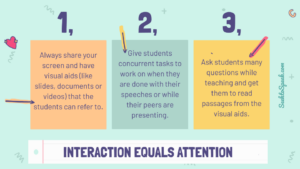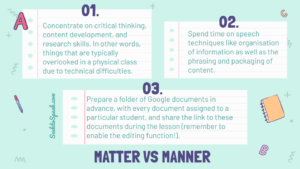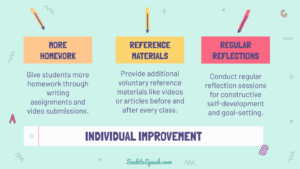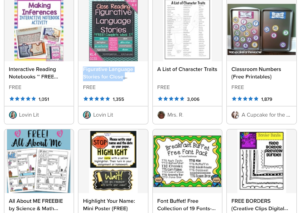While the government has announced that schools will be reopened in stages, it is unlikely that elective classes will resume physically anytime soon. This is an opportunity to make some real changes to my public speaking syllabus and teaching style.
In this article, I discuss how to maintain the students’ attention, how substance takes precedence over style, and how individual assignments are great for self-development.
How can I make sure students are paying attention in an online class?
In the comfort of their own homes, there isn’t enough scrutiny from me or their peers to compel students to pay attention. Instead of a physical presence with eyes on them at all times, now I’m just a tiny box on their small screens (which they can further minimize or even mute on their devices!)
So to maintain the students’ attention, I start by making sure I have visual aids for students to refer to at every lesson. It is not enough to just see or hear me teach; children need a visual to ground their attention and understanding. Since social interaction between students is limited in a virtual class, teacher-to-student interaction needs to be amped up. I’d constantly ask my students questions. What do you think of this? What did I just say? Do you know what this means? It keeps the students on their toes — forcing them to pay attention. Even while I’m teaching, I ask my students to read passages in the visual aids.
When students present their speeches, I ask other students to analyze the speech presented. I ask the others to repeat what the speaker’s message was or how he/she chose to interpret the topic. All these tasks keep the students busy throughout the class so they can’t afford to not pay attention.
Therefore, for every class;
1) Always share your screen and have visual aids (like slides, documents or videos) that the students can refer to;
2) Give the students concurrent tasks to work on when they are done with their speeches or while their peers present; and
3) Ask the students many questions while teaching and get them to read passages from the visual aids.

There is never a point of time in class where my students are allowed to relax because, at any turn, there is always a potential question or assigned task waiting for them — perhaps to their dismay!
This leads me to the next issue: the inevitable weight given to matter over manner.
Here’s why substance matters more than style right now
This semester, my lessons focused more on substance rather than style. It was just too difficult to teach delivery-contingent lessons like non-verbal cues or vocal expression when there are limitations on what we can see and hear in our little boxes. However, this provided a good opportunity for me to teach more complex concepts through online resources.
Things that normally wouldn’t translate well in a physical class, like general knowledge or grammar, became more productive online. For example, I remember teaching a “real world” class on logical fallacies and was met by blank and bored faces but online, there was a lot more traction. Virtually, students could see the examples on their screens, making the concept more concrete compared to a verbal explanation. I also didn’t have to waste time writing elaborate examples on the whiteboard because everything can be prepared beforehand and flashed out with ease.
I create and assign Google document templates for the students in advance to be used during class. This will be the document used by students to jot down their notes before presenting their speeches. Since the edits made during class are done in real-time, I get to see the students’ work after every class and gauge who has improved, who needs more guidance, and who just needs to put in more effort!
So to fellow public speaking teachers and coaches who need to adapt to online lessons, my advice is to:
1) Concentrate on critical thinking, content development, and research skills. In other words, things that are overlooked in a physical class due to technical difficulties;
2) Spend time on speech techniques like organising information as well as the phrasing and packaging of information; and
3) Prepare a folder of Google documents in advance, with every document assigned to a particular student, and share the link to these documents during the lesson (remember to enable the editing function).

Since children’s lives have been deeply affected by the pandemic, I’ve noticed that my students are more aware of what is happening around them. They care about the news, they discuss it with their parents, and therefore, they are able to better appreciate substance-based learning.
The last point I would like to discuss is the dilemma between individual work and group work.
Teamwork makes the dream work (but it doesn’t really work online)
I am a huge fan of group work and often assign students into teams to present a topic. Group work allows students to interact and share ideas. It also encourages everyone to speak. While my students often moan about their inability to pick their groupmates, I think it’s important to carefully curate the students in each group to ensure balance and diversity.
I loved going between groups and observing how some students take on leadership roles and how the shy ones open up to express themselves. Group presentations are also less daunting than individual speeches and take up less time, allowing me to have more time for other activities.
Unfortunately, group work does not really translate on an online platform. Since my students are quite young, it seemed impractical to put them into groups and get them to communicate on their phones. But this actually turned out to be a blessing! Since all my tasks are given individually, now everyone had to contribute and speak. In many ways, this helped my students think and speak more independently.
My students’ strengths and weaknesses were also made more apparent without hiding behind the “shield” of group work. This was great for self-development and goal-setting. I also got away with giving more homework because students seemed to have more time!
So, fellow teachers and coaches, I suggest you:
1) Give students more homework through writing assignments and video submissions;
2) Provide additional voluntary reference materials like videos or articles before and after class; and
3) Conduct regular reflection sessions for self-development and goal-setting.

